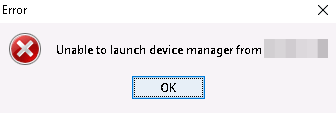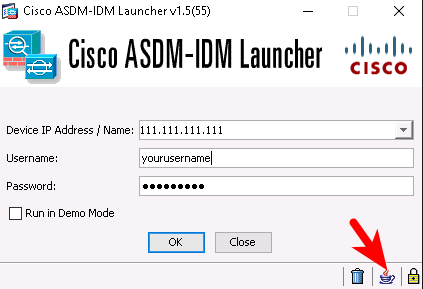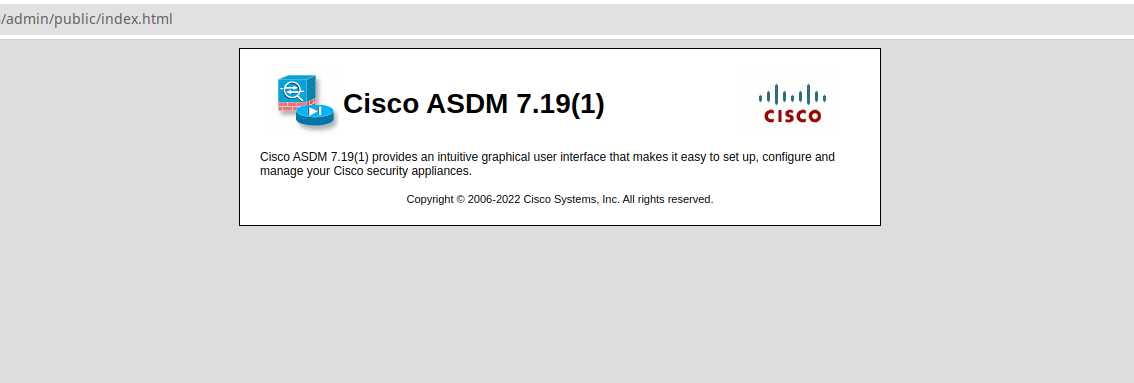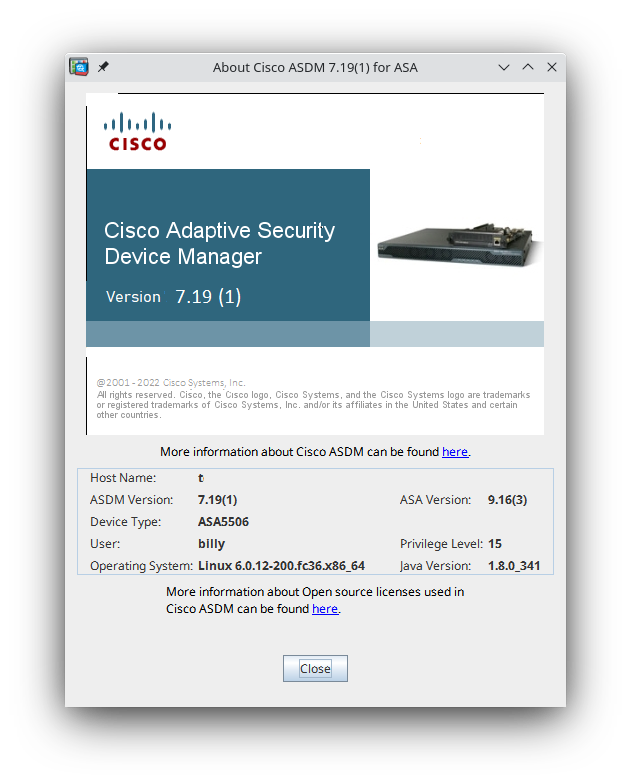Cisco ASDM Launcher fails with latest Java 8+
You have a Cisco ASDM launcher and your launcher does not start anymore with JRE 7, JRE 8, JRE 9, JRE 10, JRE 11, JRE 12+. You get the error:
Probably this issue came from an Java Update.
Table of Contents
1. Identify the error
To identify which error you have, you need to open the java console
If you find something similar to this error (exception), your java security configuration is the issue of this error:
Local Launcher Version = 1.5.55
Local Launcher Version Display = 1.5(55)
OK button clicked
Trying for ASDM Version file; url = https://111.111.111.111/admin/
javax.net.ssl.SSLHandshakeException: Received fatal alert: handshake_failure
at sun.security.ssl.Alerts.getSSLException(Unknown Source)
at sun.security.ssl.Alerts.getSSLException(Unknown Source)
at sun.security.ssl.SSLSocketImpl.recvAlert(Unknown Source)
at sun.security.ssl.SSLSocketImpl.readRecord(Unknown Source)
at sun.security.ssl.SSLSocketImpl.performInitialHandshake(Unknown Source)
at sun.security.ssl.SSLSocketImpl.startHandshake(Unknown Source)
at sun.security.ssl.SSLSocketImpl.startHandshake(Unknown Source)
at sun.net.www.protocol.https.HttpsClient.afterConnect(Unknown Source)
at sun.net.www.protocol.https.AbstractDelegateHttpsURLConnection.connect(Unknown Source)
at sun.net.www.protocol.https.HttpsURLConnectionImpl.connect(Unknown Source)
at com.cisco.launcher.y.a(Unknown Source)
at com.cisco.launcher.y.if(Unknown Source)
at com.cisco.launcher.r.a(Unknown Source)
at com.cisco.launcher.s.do(Unknown Source)
at com.cisco.launcher.s.null(Unknown Source)
at com.cisco.launcher.s.new(Unknown Source)
at com.cisco.launcher.s.access$000(Unknown Source)
at com.cisco.launcher.s$2.a(Unknown Source)
at com.cisco.launcher.g$2.run(Unknown Source)
at java.lang.Thread.run(Unknown Source)
Trying for IDM. url=https://111.111.111.111/idm/idm.jnlp/
javax.net.ssl.SSLHandshakeException: Received fatal alert: handshake_failure
at sun.security.ssl.Alerts.getSSLException(Unknown Source)
at sun.security.ssl.Alerts.getSSLException(Unknown Source)
at sun.security.ssl.SSLSocketImpl.recvAlert(Unknown Source)
at sun.security.ssl.SSLSocketImpl.readRecord(Unknown Source)
at sun.security.ssl.SSLSocketImpl.performInitialHandshake(Unknown Source)
at sun.security.ssl.SSLSocketImpl.startHandshake(Unknown Source)
at sun.security.ssl.SSLSocketImpl.startHandshake(Unknown Source)
at sun.net.www.protocol.https.HttpsClient.afterConnect(Unknown Source)
at sun.net.www.protocol.https.AbstractDelegateHttpsURLConnection.connect(Unknown Source)
at sun.net.www.protocol.http.HttpURLConnection.getInputStream0(Unknown Source)
at sun.net.www.protocol.http.HttpURLConnection.getInputStream(Unknown Source)
at sun.net.www.protocol.https.HttpsURLConnectionImpl.getInputStream(Unknown Source)
at com.cisco.launcher.w.a(Unknown Source)
at com.cisco.launcher.s.for(Unknown Source)
at com.cisco.launcher.s.new(Unknown Source)
at com.cisco.launcher.s.access$000(Unknown Source)
at com.cisco.launcher.s$2.a(Unknown Source)
at com.cisco.launcher.g$2.run(Unknown Source)
at java.lang.Thread.run(Unknown Source)
2. What is the root cause?
Oracle has disabled any well known unsafe and unsecure cipher and algorithm. You can re-enable this again, but sadly you have to enable it fully for the complete installation of Java. This means you have to enable unsecure protocols for any java application. Typically it is no issue, but could be in some security relevant environments.
3. How to fix it?
Best way would be to upgrade your Firewall to later Software version. Sometimes this is not possible. In this case you have to stick to the outdated Cisco Software, and you have to find a solution locally in Java.
3.1. Modify the existing JRE for your Cisco ASDM
find out your active java version by typing in your command line
Now go to your JRE version specific folder, which is typically under
Windows: C:\Program Files\Java\jre
and open it in your prefered editor (open the editor as administrator or with sudo)
Now find the section which contains this:
jdk.tls.disabledAlgorithms=SSLv3, RC4, DES, MD5withRSA, DH keySize < 1024, \
EC keySize < 224, 3DES_EDE_CBC, anon, NULL
#jdk.tls.disabledAlgorithms=SSLv3, RC4, DES, MD5withRSA, DH keySize < 1024, \
# EC keySize < 224, 3DES_EDE_CBC, anon, NULL
jdk.tls.disabledAlgorithms=SSLv3, RC4, DES, MD5withRSA, DH keySize < 1024, \
EC keySize < 224, anon, NULL
restart your ASDM and the issue shall be gone
If the issue still persists connect with your browser to the ASDM (https://) in the above example it was
and open in the Browser the SSL details of your connection
3.2. Prepare a dedicated JRE only for Cisco ASDM (hard way, but more secure)
In this variant you clone a JRE to a different folder and you only use this JRE for the ASDM. This is the most secure way for all other application, since you limit the bad unsecure protocols to Cisco ASDM only.
To achieve this, copy your existing JRE to a special location, and create a script which sets JAVA_HOME and PATH to run java from this new folder.
Running Cisco ASDM 7.18 or 7.19 on Linux
ASDM 7.18 ending support for Java Web Launch—Starting with ASDM 7.18, ASDM will no longer support Java Web Start due to Oracle’s end of support for JRE 8 and Java Network Launching Protocol (JNLP). You will have to install the ASDM Launcher to launch ASDM.
And, sure enough, if you upgrade to 7.18 or 7.19 and do the normal steps with javaws that have worked for a dozen years now, you'll get a FileNotFoundException and no ASDM.
JNLPException[category: Download Error : Exception: java.io.FileNotFoundException: https://192.168.1.1/admin/public/asdm.jnlp : LaunchDesc: null at com.sun.javaws.Main.launchApp(Unknown Source) . Caused by: java.io.FileNotFoundException: https://192.168.1.1/admin/public/asdm.jnlp at sun.net.www.protocol.http.HttpURLConnection.getInputStream0(HttpURLConnection.java:1896) . Looking a little more closely, yeah, that JNLP file is gone, and even using an old version of it to point at the updated server errors in a strange way. Well that's annoying.
Luckily, if we look at the old JNLP, it isn't really doing much. It downloads some jars, sets some parameters, then runs a Launcher class with some arguments in there. That tells us that whatever it's doing now is probably not any more complicated than those steps, just wrapped in a different installer package. Luckily as well, the ASDM has a MacOS-friendly DMG package that we can get access to.
So, let's grab that DMG and do the steps that the JNLP would have done in a more manual fashion.
- You're the kind of person who is ok with running an untested, hacky tool to manage your network equipment. If so, good for you. You're in good company here.
- This assumes you've got a legit copy of the asdm-openjre-7191.bin file. If not, contact your authorized Cisco reseller.
- You should also have that ASDM binary installed on legit hardware, and have a login available.
- This also assumes you've got a java 8 on your path. Even though this is openjre, I ended up using the Oracle spin of it, though as we'll see later the MacOS package includes the Zulu jre. Also, it wants Java 8, later than 8u261. Boo. If you're not comfortable with the dry, esoteric java installation instructions from Oracle proper, (and honestly, even if you are) I strongly recommend using something like SDKMan to make your java vm life easier.
In these examples, I'll use 192.168.1.1 as the address of the admin portal. Adjust your steps and ports and such accordingly.
First, get the DMG. Crack open a browser and head to the admin portal. On my linux system, it provides nothing, no buttons, no options
Switch up the URL. Remove the /public/index.html and add dm-launcher.dmg . It'll look similar to https://192.168.1.1/admin/dm-launcher.dmg then ask you for a login. Use your ASDM username and password, that'll download the DMG.
Next, make sure you've got the right tools installed. Add dmg2img and something that can read (we don't need to write) Apple's APFS. On my Fedora system that looked like
dnf install dmg2img apfs-fuse Next, extract the relevant part of the DMG. Find the one that has the actual data, not the boot sector and GPT stuff.
$ dmg2img -l dm-launcher.dmg dmg2img v1.6.5 (c) vu1tur (to@vu1tur.eu.org) dm-launcher.dmg --> (partition list) partition 0: Protective Master Boot Record (MBR : 0) partition 1: GPT Header (Primary GPT Header : 1) partition 2: GPT Partition Data (Primary GPT Table : 2) partition 3: (Apple_Free : 3) partition 4: disk image (Apple_APFS : 4) partition 5: (Apple_Free : 5) partition 6: GPT Partition Data (Backup GPT Table : 6) partition 7: GPT Header (Backup GPT Header : 7) That command shows that partition 4 is the one we're after. Let's extract that.
$ dmg2img -p 4 dm-launcher.dmg dmg2img v1.6.5 (c) vu1tur (to@vu1tur.eu.org) dm-launcher.dmg --> dm-launcher.img decompressing: opening partition 4 . 100.00% ok Warning: wrote 129982464 bytes, expected 130020864 Wrote 38400 padding bytes Archive successfully decompressed as dm-launcher.img You should be able to mount the image [as root] by: modprobe hfsplus mount -t hfsplus -o loop dm-launcher.img /mnt The mount instructions are lying. HFSPlus is not the same as the APFS we saw in the list.
$ mkdir asdm-img $ sudo mount -t apfs -o loop dm-launcher.img ./asdm-img Alright, now we're pretty close. Doing much of anything with the image requires root, so probably do a sudo -i to get a root shell. Looking through the image, we can find a bunch of jar files, some certificate stuff, and a script that ties them together. It also ships a version of the Zulu 8 JRE, instead of the Oracle one. Neat.
# ls 'asdm-img/root/Cisco ASDM-IDM.app/Contents/Resources/Java/' AC_HS.PEM cert.PEM demo dm-launcher.jar jploader.jar jre lzma.jar retroweaver-rt-2.0.jar # ls 'asdm-img/root/Cisco ASDM-IDM.app/Contents/Resources/Java/jre' ASSEMBLY_EXCEPTION bin DISCLAIMER lib LICENSE man readme.txt release THIRD_PARTY_README Welcome.html zulu-8.jre Importantly, these are the same jar files that we saw in the JNLP file. That implies that it's the same codebase, just wrapped in a different distribution file. Extra neat.
If we take a look at the script at ./asdm-img/root/Cisco ASDM-IDM.app/Contents/MacOS/dm-launcher.sh we can see what the package does. Almost all of the script is trying to figure out how to run java. It finds the locally installed one, makes sure it's the right version, does some plist magic, then runs a big long java line. The script can almost be used as-is, but there's a little too much MacOS pathing and tooling assumed in there.
Let's finish the extraction. Almost there.
Make a directory, pull the resources we found in there, and make a script that will run the big long java command from the bottom of dm-launcher.sh . We're still root to be able to read that wacky APFS image, so put some chown in there too.
TARGET_DIR=/home/username/asdm-7191 TARGET_USER=username mkdir -p "$TARGET_DIR" cp "asdm-img/root/Cisco ASDM-IDM.app/Contents/Resources/Java/"* "$TARGET_DIR" cat > "$TARGET_DIR/asdm.sh" That'll do what we said. Now, you should be able to run that asdm.sh script and see the login box come up. Log in normally and you're in good shape
One error message I ran into while doing this annoyed me.
Exception in thread "main" java.lang.ExceptionInInitializerError at com.cisco.launcher.t.if(Unknown Source) at com.cisco.launcher.Launcher.main(Unknown Source) Caused by: java.lang.ArrayIndexOutOfBoundsException: Index 1 out of bounds for length 1 at com.cisco.launcher.ClassUtil.(Unknown Source) . 2 more This ended up being caused by the Cisco launcher trying to parse the version string of a JRE from later than Java 8, and not being able to do that. My solution was just to use a Java 8 JRE with this process.



